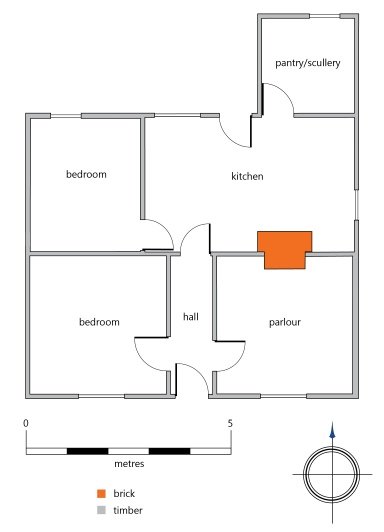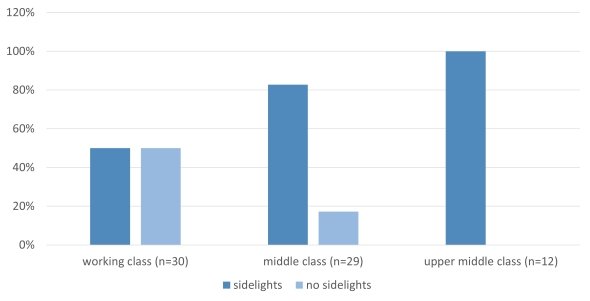I know, I know: doors, on the face of it, are not the least bit mysterious. They’re quite solid and stable and kind of unassuming. I mean, they might feature in the odd drama – door slammed! – or serve as a tightly guarded boundary by a child – keep out! – but these are (hopefully) occasional roles. And for the most part, I’m guessing you don’t think too much about them – unless they start squeaking, of course… Before we get to the mysterious aspects of doors, let’s start by considering their function of a door. Which probably seems barely worthy of consideration, but bear with me.
A particularly fabulous late Victorian internal door. Image: F. Bradley.
At their most basic, doors provide access to a room. In so doing, they can also serve to keep heat in, or dust and dirt out. They can also keep noise and smells in (or out). Doors, then, are also a means of control – they help control the climate and environment of a room. They also control access: a closed door effectively means knock before entering, while an open door invites entry freely. Thus, they become part of a boundary, between spaces, or between people. In this way, doors can be used to control social interactions, essentially establishing boundaries between those in the room and those outside. In Victorian homes where servants were employed, such a mechanism could have been used to separate servants from family members and their activities.
If these were the function of a door, what of its appearance? Well, by far the most common internal door form in 19th century Christchurch was a four-panel door with a low lockrail (internal doors are my focus here today). In these doors, which you’re probably familiar with, the panels are set into bed mouldings. The position of the lockrail is important – this is where the handle and, perhaps more obviously, the lock were set, and a low lockrail was at about hand-height for most adults. But here’s the thing. The position of the lockrail changes in the early 20th century and becomes high – still perfectly reachable for an adult, but not so for a child. This has long intrigued me, because it’s the Victorian era that we think of as being that of children being seen and not heard. But a child could easily have opened a door in a Victorian era house. Not so much an Edwardian era one.
A typical Victorian era internal door, with four panels and a low lock rail. Image: K. Webb.
A typical Edwardian era internal door, also with four panels, but with a high lock rail. Image: K Webb.
Why, then, this change? I wish I knew. The simplest answer is fashion, but there is always a reason why fashions change – this is the whole point of material culture studies: nothing happens just because. There is a bigger shift that’s going on in New Zealand at around this time, with society becoming less formal. This sees a number of changes in houses, and the way space in them is used, but increasing the height of the door handle doesn’t fit with this (Leach 2000: 84-85). It may simply have been that doors needed to change, to look different, to mark those broader changes that were taking place.
But here’s another thing about those 19th century internal doors: they all had locks, presumably for extra security. As someone who’s not particularly good at locking even external house doors, this one bemuses me – and the crime rate in 19th century Christchurch was not that high. But the crime rate in the cities and countries Christchurch’s colonial settlers had left behind may have been, and so people may simply have been used to locks on internal doors as a standard thing. Edwardian internal doors also all had locks – in fact, I’m fairly certain locks on internal doors were a thing until at least World War II, but I don’t know exactly when they ceased to be the norm (nor when they first became common). The fact, though, that doors continued to be made with locks suggests that this was functionality that people wanted. I am curious, though, about when these locks stopped being the norm, and why that might have happened.
Which brings me to my final door conundrum: the position of them and the way they opened. It was by no means always the case, but doors were typically positioned in the middle of a wall. I appreciate that this doesn’t seem like a big deal, but if you live in a modern house, well, for starters, there are probably far fewer doors per room than there were in a Victorian house. But, more pertinent to the current discussion, in a modern house the door is typically at one end of a wall, and it opens back against the adjoining wall (in some cases, this was the only option, thanks to the layout of the house). Which makes sense, right? This way, the door doesn’t obscure the room and nor does it take up unnecessary space. But in 19th century houses, even when the door was at one end of the wall, it typically opened into the room, rather than swinging back against the adjoining wall. And in rooms where the door was positioned more centrally, it often opened in such a way that it obscured the bulk of the room as you entered (if you had to open the door when you entered). Why might this have been the case?
A standard villa, Bassett Street, Christchurch, c.1898. Notice how the doors into Rooms 2 & 8 are positioned centrally in the walls, and the way they open essentially obscures the room as you enter. Meanwhile, the doors into the other rooms are positioned at one end of the wall (which is unusual), but the doors do not swing back against the adjoining wall, but instead swung into the room. Image: P. Mitchell and K. Watson.
It’s hard to know. Was it a concern for doors swinging back against the adjoining wall and damaging the latter that led to the angle of opening? Did a door opening into a room, and obscuring part of the room as it was opened, provide more of a sense of drama, more of a slow reveal of the contents of that room (remembering that Victorians had A LOT of things on display)? Or did it help to preserve the privacy of those in the room, particularly in a house where there were servants (and there were concerns about separating families and their servants; Leach 2000: 80, Macdonald 2000: 42)? Was that the door, with its moulded door surround, was more of a feature within a room if it were centrally positioned, and thus became part of the room’s display, as it were?
See? Doors are maybe not quite so immediately knowable as you thought. The mysteries they pose are not huge ones, but resolving them would help us to better understand human behaviours in the past, including people’s attitudes towards their house and the use of space in it, towards security and towards their relationships with other people, particularly other people with whom they shared their house. Human behaviours shift in response to and in line with broader changes in society, to changes in economic systems, morals and belief systems, amongst other things. These behaviours are not just reflected in our material culture – such as houses – but are negotiated through it.
Katharine Watson
References
Leach, H., 2000. The European house and garden in New Zealand: a case for parallel development. In: B. Brookes, ed. At Home in New Zealand: Houses, History, People. Wellington: Bridget Williams Books, pp.73-88.
Macdonald, C., 2000. Strangers at the hearth: the eclipse of domestic service in New Zealand homes c.1830s-1040s. In: B. Brookes, ed. At Home in New Zealand: Houses, History, People. Wellington: Bridget Williams Books, pp.41-56.





































